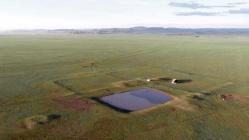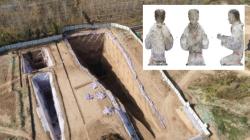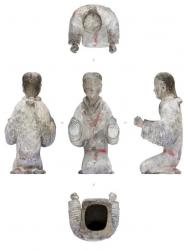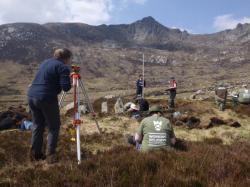ONLINE COURSES / COURS A DISTANCE
AUTUMN TERM : OCTOBER 2020
REGISTER NOW
VIET NAM –  Ba Be - During the recent field survey in Ba Be National Park in the northeastern province of Bac Kan, archaeologists have found many traces of early humans in caves in karst mountains around Ba Be Lake. Traces were found in Tham Kit Cave, Tham Mya Cave, Na Phoong Cave, and Ba Cua Cave in Nam Mau commune, Ba Be district. Most traces were uncovered in Tham Kit Cave, which is 50m above the lake surface. The cave faces southwest while its inside measures nearly 3,000 square metres. Its floor is fairly smooth and divided into three large rooms with many small corners. There are many big stones inside the cave, which are believed to have fallen from the cave’s roof during big geological changes in the past. Scientists discovered many carved tools from stones, and one single layer of culture of 50cm thick formed by clay inside the cave containing ancient objects, bones and teeth of animals. They also found more than 50 stone objects and traces of an oven.The bones and teeth of animals found in the semi-fossilised form are believed to be remains of food left by early humans. Particularly, excavators found a small flat pebble bar with two holes of some 1.2cm in diameter on the surface. The object seemed to have been carefully carved and cut; however, its usage is still a mystery. Traces of semi-fossilised bones, teeth and stone objects showed that hunting and picking vegetables and fruits were fairly important in how early humans sought food. Chung confirmed that based on a general examination of objects, traces and sedimentary soil, scientists believe Tham Kit Cave was a residential area of early humans in the late period of the old Stone Age, some 20,000 years ago. Excavators have also found stone objects of Hoa Binh Civilisation (12,000-10,000 BC) in nearby Tham Mya Cave and many ceramic objects of the Metal Age in Na Phoong and Ba Cua caves./.
Ba Be - During the recent field survey in Ba Be National Park in the northeastern province of Bac Kan, archaeologists have found many traces of early humans in caves in karst mountains around Ba Be Lake. Traces were found in Tham Kit Cave, Tham Mya Cave, Na Phoong Cave, and Ba Cua Cave in Nam Mau commune, Ba Be district. Most traces were uncovered in Tham Kit Cave, which is 50m above the lake surface. The cave faces southwest while its inside measures nearly 3,000 square metres. Its floor is fairly smooth and divided into three large rooms with many small corners. There are many big stones inside the cave, which are believed to have fallen from the cave’s roof during big geological changes in the past. Scientists discovered many carved tools from stones, and one single layer of culture of 50cm thick formed by clay inside the cave containing ancient objects, bones and teeth of animals. They also found more than 50 stone objects and traces of an oven.The bones and teeth of animals found in the semi-fossilised form are believed to be remains of food left by early humans. Particularly, excavators found a small flat pebble bar with two holes of some 1.2cm in diameter on the surface. The object seemed to have been carefully carved and cut; however, its usage is still a mystery. Traces of semi-fossilised bones, teeth and stone objects showed that hunting and picking vegetables and fruits were fairly important in how early humans sought food. Chung confirmed that based on a general examination of objects, traces and sedimentary soil, scientists believe Tham Kit Cave was a residential area of early humans in the late period of the old Stone Age, some 20,000 years ago. Excavators have also found stone objects of Hoa Binh Civilisation (12,000-10,000 BC) in nearby Tham Mya Cave and many ceramic objects of the Metal Age in Na Phoong and Ba Cua caves./.
https://en.vietnamplus.vn/traces-of-early-humans-found-in-ba-be-national-park/178847.vnp
CANADA –  Melita - A recent archeological find in southwestern Manitoba could reveal more about the lives of Indigenous farmers before colonization. The site south of Melita, Man., was discovered in 2018 by Eric Olson, said Mary Malainey, an archaeology professor at Brandon University. Olson, who the site is now named after, found modified bison shoulder blades (or scapulae) along a creek bank. Those bones would have been used as gardening tools like hoes by the people who lived there, Malainey said. She said it's likely flooding in 2014 brought them to the surface. "It's only the second site in Manitoba with really good evidence of pre-contact Indigenous gardening or farming," said Malainey. The tools found there are similar to ones found at a site in Lockport, Malainey said. But the Lockport site was disturbed and eroded, making it tough for archeologists to glean information from what they found there. The scapulae suggest the people who left them were farmers or gardeners, but what the rest of the site might unearth is still to be determined, she said — like where exactly they lived and whether they moved from one place to another. Initial site testing started last year and the research and public archeology program is on this summer. Experts will collect soil cores from the site to study the remains of crops and other plants recovered at the site. The team will also do a ground-penetrating radar survey to scan the surrounding prairie and try to find the area's former village.
Melita - A recent archeological find in southwestern Manitoba could reveal more about the lives of Indigenous farmers before colonization. The site south of Melita, Man., was discovered in 2018 by Eric Olson, said Mary Malainey, an archaeology professor at Brandon University. Olson, who the site is now named after, found modified bison shoulder blades (or scapulae) along a creek bank. Those bones would have been used as gardening tools like hoes by the people who lived there, Malainey said. She said it's likely flooding in 2014 brought them to the surface. "It's only the second site in Manitoba with really good evidence of pre-contact Indigenous gardening or farming," said Malainey. The tools found there are similar to ones found at a site in Lockport, Malainey said. But the Lockport site was disturbed and eroded, making it tough for archeologists to glean information from what they found there. The scapulae suggest the people who left them were farmers or gardeners, but what the rest of the site might unearth is still to be determined, she said — like where exactly they lived and whether they moved from one place to another. Initial site testing started last year and the research and public archeology program is on this summer. Experts will collect soil cores from the site to study the remains of crops and other plants recovered at the site. The team will also do a ground-penetrating radar survey to scan the surrounding prairie and try to find the area's former village.
https://www.cbc.ca/news/canada/manitoba/ancient-goes-bison-scapula-melita-archeology-1.5655459?cmp=rss
MONGOLIE –  - Archaeologists conducting excavations in central Mongolia along the Orkhon River believe they have discovered the “Dragon City” of Luut/Luncheng, the Xiongnu/Khunnu capital. The Xiongnu were a tribal confederation that inhabited the eastern Eurasian Steppe from the 3rd century BC to the late 1st century AD. The ruler of the Xiongnu was called the Chanyu, who exercised direct authority over the central territory from Luncheng. Iderkhangai Tumur-Ochir, leader of the archaeological research team from Ulaanbaatar State University said: “The city is believed to have originated in the Khangai Mountains of Mongolia, according to ancient sources.” The researchers revealed that the city has a double wall and a man-made pool used for water management or a reservoir. Excavations found the remains of a structure that was decorated with an ancient kanji inscription stating, “Son of Heaven” which is the first evidence found within the region to suggest the site is the Dragon City of Luncheng.
- Archaeologists conducting excavations in central Mongolia along the Orkhon River believe they have discovered the “Dragon City” of Luut/Luncheng, the Xiongnu/Khunnu capital. The Xiongnu were a tribal confederation that inhabited the eastern Eurasian Steppe from the 3rd century BC to the late 1st century AD. The ruler of the Xiongnu was called the Chanyu, who exercised direct authority over the central territory from Luncheng. Iderkhangai Tumur-Ochir, leader of the archaeological research team from Ulaanbaatar State University said: “The city is believed to have originated in the Khangai Mountains of Mongolia, according to ancient sources.” The researchers revealed that the city has a double wall and a man-made pool used for water management or a reservoir. Excavations found the remains of a structure that was decorated with an ancient kanji inscription stating, “Son of Heaven” which is the first evidence found within the region to suggest the site is the Dragon City of Luncheng.
https://www.heritagedaily.com/2020/07/archaeologists-discover-the-lost-dragon-city-capital-of-xiongnu-empire/134256
FRANCE – Pallet - Sous les friches des parcelles d’un futur lotissement situé au Pallet (Loire-Atlantique), une campagne de fouilles a permis de révéler une vie passée qui était jusqu’alors totalement inconnue. Le terrain révèle deux grandes traces de fossé qui structurent l’espace. Un grand fossé en courbe parallèle à la rivière et un autre qui dessine grossièrement un carré de 50 m de côté tangent au grand fossé. Ce carré serait la représentation d’une grosse ferme gauloise de l’âge de fer entre -400 et -100 avant J.-C. Le grand fossé en courbe est lui beaucoup plus vieux et serait du Néolithique entre -4 500 et -2 000 avant J.-C. comme l’attestent des silex taillés. Cet ensemble est assez original et pas connu dans la région nantaise. » Sur le sol, de très nombreux impacts de trous sont repérés. Ils accueillaient des poteaux de bois dont certains de fort diamètre et la géométrie qui les réunit indique des formes hypothétiques d’habitat. Dans les semaines à venir, le chantier va prendre une autre ampleur avec le creusement des fossés pour moitié afin de rechercher des objets, de la poterie (marqueur de datation), des morceaux de fours, de la céramique, des bouts de meule…« Nous pouvons aussi penser, au regard de l’importance et de l’activité présumée du site, qu’il comportait une forge même si les chances d’en trouver des traces sont minces. Par ailleurs, trouver des objets d’art révélant un passé cultuel relève d’une chance inouïe. »
https://actu.fr/pays-de-la-loire/le-pallet_44117/pres-de-nantes-sous-le-futur-lotissement-les-fouilles-revelent-des-vestiges-d-une-grosse-ferme-gauloise_35003234.html
CHINE – 
 Xi'an - Archaeologists working at the starting point of the Silk Road in northwest China’s Shaanxi province have unearthed a group of ancient tombs dating back around 2,000 years to the early days of the Han dynasty. A total of 27 ancient tombs were excavated in the provincial capital Xi’an and a hoard of objects, including ceramic figurines and thousands of pieces of jade clothing were found. Four of the tombs are large in scale and experts say they are the final resting places of important people of the day. More than 2,200 pieces of jade clothing were unearthed in the grandest of the tombs and their restoration will provide an important reference for the study of the jade clothes system during the reign of the dynasty. The excavation of the tombs is also set to yield valuable insights into the burial customs of the time. The Han dynasty ran from 202 BC to 220 AD and is considered a golden age in Chinese history. The Silk Road trade route was established during this time and its starting point in Xi’an contributed to the city being one of China’s Four Great Ancient Capitals. The ceramic figurines unearthed in the discovery announced on Monday are of particular interest to archaeologists. Xi'an is also the home of the famous Terracotta Army of China’s first Emperor Qin Shi Huang. The extraordinary sculptures date back to just a few years before the establishment of the Han dynasty.
Xi'an - Archaeologists working at the starting point of the Silk Road in northwest China’s Shaanxi province have unearthed a group of ancient tombs dating back around 2,000 years to the early days of the Han dynasty. A total of 27 ancient tombs were excavated in the provincial capital Xi’an and a hoard of objects, including ceramic figurines and thousands of pieces of jade clothing were found. Four of the tombs are large in scale and experts say they are the final resting places of important people of the day. More than 2,200 pieces of jade clothing were unearthed in the grandest of the tombs and their restoration will provide an important reference for the study of the jade clothes system during the reign of the dynasty. The excavation of the tombs is also set to yield valuable insights into the burial customs of the time. The Han dynasty ran from 202 BC to 220 AD and is considered a golden age in Chinese history. The Silk Road trade route was established during this time and its starting point in Xi’an contributed to the city being one of China’s Four Great Ancient Capitals. The ceramic figurines unearthed in the discovery announced on Monday are of particular interest to archaeologists. Xi'an is also the home of the famous Terracotta Army of China’s first Emperor Qin Shi Huang. The extraordinary sculptures date back to just a few years before the establishment of the Han dynasty.
https://www.rt.com/news/495312-ancient-tombs-discovered-china-han-dynasty/
ROYAUME UNI –  Arran - RADIOCARBON dating of burnt wood unearthed at a roundhouse has given archaeologists new insights into Bronze Age life in Scotland. National Trust for Scotland’s Thistle Camp participants joined the charity’s head of archaeological services, Derek Alexander, in an excavation in 2017 of Arran’s highest round house at 384 metres above sea level, in Coire a’ Bhradain above Glen Rosa, and dates back 3300 years. The dig revealed a central hearth area of stone and clay with remnants of hazel charcoal. The charcoal was submitted to the Scottish University Environmental Research Centre (SUERC) for a radiocarbon date, which revealed that the round house was occupied around 1400-1300 BC. In a report published on the findings, Alexander and his team suggest the Coire a’Bhradain site was used as temporary shelter during deer hunting trips through a pass at the top of the coire, or as a seasonal shielding site to keep grazing animals out on the hill. The site of the roundhouse was discovered in 2001 by members of the Arran Mountain Rescue Team. It was exposed by a huge wild fire which revealed a raised circle with two prominent “doorway” stones.
Arran - RADIOCARBON dating of burnt wood unearthed at a roundhouse has given archaeologists new insights into Bronze Age life in Scotland. National Trust for Scotland’s Thistle Camp participants joined the charity’s head of archaeological services, Derek Alexander, in an excavation in 2017 of Arran’s highest round house at 384 metres above sea level, in Coire a’ Bhradain above Glen Rosa, and dates back 3300 years. The dig revealed a central hearth area of stone and clay with remnants of hazel charcoal. The charcoal was submitted to the Scottish University Environmental Research Centre (SUERC) for a radiocarbon date, which revealed that the round house was occupied around 1400-1300 BC. In a report published on the findings, Alexander and his team suggest the Coire a’Bhradain site was used as temporary shelter during deer hunting trips through a pass at the top of the coire, or as a seasonal shielding site to keep grazing animals out on the hill. The site of the roundhouse was discovered in 2001 by members of the Arran Mountain Rescue Team. It was exposed by a huge wild fire which revealed a raised circle with two prominent “doorway” stones.
https://www.thenational.scot/news/18595363.arran-roundhouse-gives-new-insight-bronze-age-life/
ROYAUME UNI –  Wendover - Skeletal remains believed to be an Iron Age execution victim have been found outside London. Archaeologists recently made the gruesome find at a dig site on Wellwick Farm, near Wendover, about 25km north-west of London's outskirts. Rachel Wood, the archaeologist leading the site excavation, said while they don't know how the man died, his body position indicates he was likely murdered. "He seems to have had his hands tied, and he was face-down in the bottom of the ditch," The remains are believed to be more than 2500 years old and there are no signs to indicate it was a grave or formal burial location. Scientists are now running forensic tests on the skeletal remains as well as pottery fragments found nearby to determine a possible cause of death. "If he was struck across the head with a heavy object, you could find a mark of that on the back of the skull," Dr Wood said. "If he was stabbed, you could find blade marks on the ribs, so we're hoping to find something like that, to tell us how he died." The area is covered with ancient sites, with the man's remains found less than a kilometre away from another site, Icknield Way, a set of paths that run along the top of Chiltern Hills, used since prehistoric times. Dr Wood's team also found signs of an ancient village near the burial site, believed to be occupied during the Bronze Age more than 3000 years ago, until most of Britain was invaded by the Roman Empire about 2000 years ago. They found evidence of animal pens, food storage and a dwelling similar to those used during that period.
Wendover - Skeletal remains believed to be an Iron Age execution victim have been found outside London. Archaeologists recently made the gruesome find at a dig site on Wellwick Farm, near Wendover, about 25km north-west of London's outskirts. Rachel Wood, the archaeologist leading the site excavation, said while they don't know how the man died, his body position indicates he was likely murdered. "He seems to have had his hands tied, and he was face-down in the bottom of the ditch," The remains are believed to be more than 2500 years old and there are no signs to indicate it was a grave or formal burial location. Scientists are now running forensic tests on the skeletal remains as well as pottery fragments found nearby to determine a possible cause of death. "If he was struck across the head with a heavy object, you could find a mark of that on the back of the skull," Dr Wood said. "If he was stabbed, you could find blade marks on the ribs, so we're hoping to find something like that, to tell us how he died." The area is covered with ancient sites, with the man's remains found less than a kilometre away from another site, Icknield Way, a set of paths that run along the top of Chiltern Hills, used since prehistoric times. Dr Wood's team also found signs of an ancient village near the burial site, believed to be occupied during the Bronze Age more than 3000 years ago, until most of Britain was invaded by the Roman Empire about 2000 years ago. They found evidence of animal pens, food storage and a dwelling similar to those used during that period.
https://www.9news.com.au/world/iron-age-execution-victim-found-tied-and-buried-along-uk-trainline-construction-site/1f2ac290-b067-4e77-a233-fc8923934421